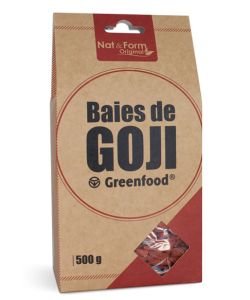Goji berries are especially valued for their nutritional value (vitamin C, 18 amino acids, vitamin B ...). Produced from eco-responsible manner, they are controlled over 300 pesticides.
Goji berries: longevity fruit
Nat & Form Goji is Lycium Barbarum and the variety is grown in the small province of Ningxia in the south of inner Mongolia. This is the reference region for the cultivation of wolfberries.
Indication
The qualitative criteria of Goji:
Its basic concept and objectives allow the continuous improvement of food quality and safety:
Its basic concept and objectives allow the continuous improvement of food quality and safety:
- Fruit products according to criteria of sustainable development.
- No environmental pollution during production.
- Fair compensation for producers and strict compliance with European standards.
- Control + 300 pesticides.
- Organics equivalent quality goji.
Properties
The goji berry is particularly rich in:
- Vitamin C: 5 times greater than that of the orange.
- 18 amino acids, 8-called essential including letryptophane and isoleucine.
- B vitamins, including B1, B2, B3, B5, B6, B8 and B12.
- 21 minerals and trace elements Zinc, Iron, Copper, Selenium, and Phosphorus.
Use
20 to 30 g per day.
The daily dosage can be adapted according to the needs. It is recommended to consume Goji berry hour after lunch and avoid taking in the evening because of its stimulating properties.
The daily dosage can be adapted according to the needs. It is recommended to consume Goji berry hour after lunch and avoid taking in the evening because of its stimulating properties.
Composition
GreenFood Goji berry (Lycium barbarum).
Special precautions
- Food supplements should be used as part of a healthy lifestyle and not be used as substitutes for a varied and balanced diet.
- Do not exceed the recommended daily dose.
- Keep out of reach of children.
- The conservation is done in a dry place and away from light.
- Goji berries can be kept for a period of 12 months without loss of nutritional quality.
- It is best to keep them in an airtight container.
Packing
Bag of 500 g
Nat & Form
Nat & Form
This site contains a significant amount of information. This is not a medical site. The exempted reflections, can never be a substitute for a consultation with a doctor or therapist that you return for your follow-up contact.
Comment (12) -
Comments from others countries
Veronique J.
55-65 years

06/06/2018
Bon produit à un prix très abordable
Charles C.
55-65 years

09/02/2018
Très bon rapport qualité/prix.
Estelle C.
45-55 years

23/10/2017
le produit est tel que je l'attendais, merci
hiuh
> 65 years

28/09/2017
Très bon produit qualité et le prix 100% d'une agriculture Bio nous avons vérifié par des tests astuces de géobiologue. A conseiller
pat p.
> 65 years

03/05/2017
Nous connaissons ce produit et en sommes toujours contents
Isabelle D.
55-65 years

05/02/2017
très bien rapport qualité /prix.
Chantal C.
> 65 years

22/04/2016
Complément dont je connais bien les effet energétiques
Zuzanna D.
 04/03/2016
04/03/2016
très bon rapport qualité/prix
Nathalie V.
 13/01/2016
13/01/2016
Super, je n avais jamais gouté auparavant. Au début, je n'ai pas trop aimé mais en fait je ne le mange pas tout seul mais par-dessus d autres aliments et là, c'est trop bon, ça relève bien les plats.
Corinne C.
55-65 years

09/12/2015
très bonnes, mouelleuses à souhait
More reviews
Log in to add a comment.New client ?
Start here .
Customers who bought this product also purchased

Copyright© 2004-2025 Idily n°Siret 51151936500015 - VAT number FR65511519365 - VAT number BE0425925218

